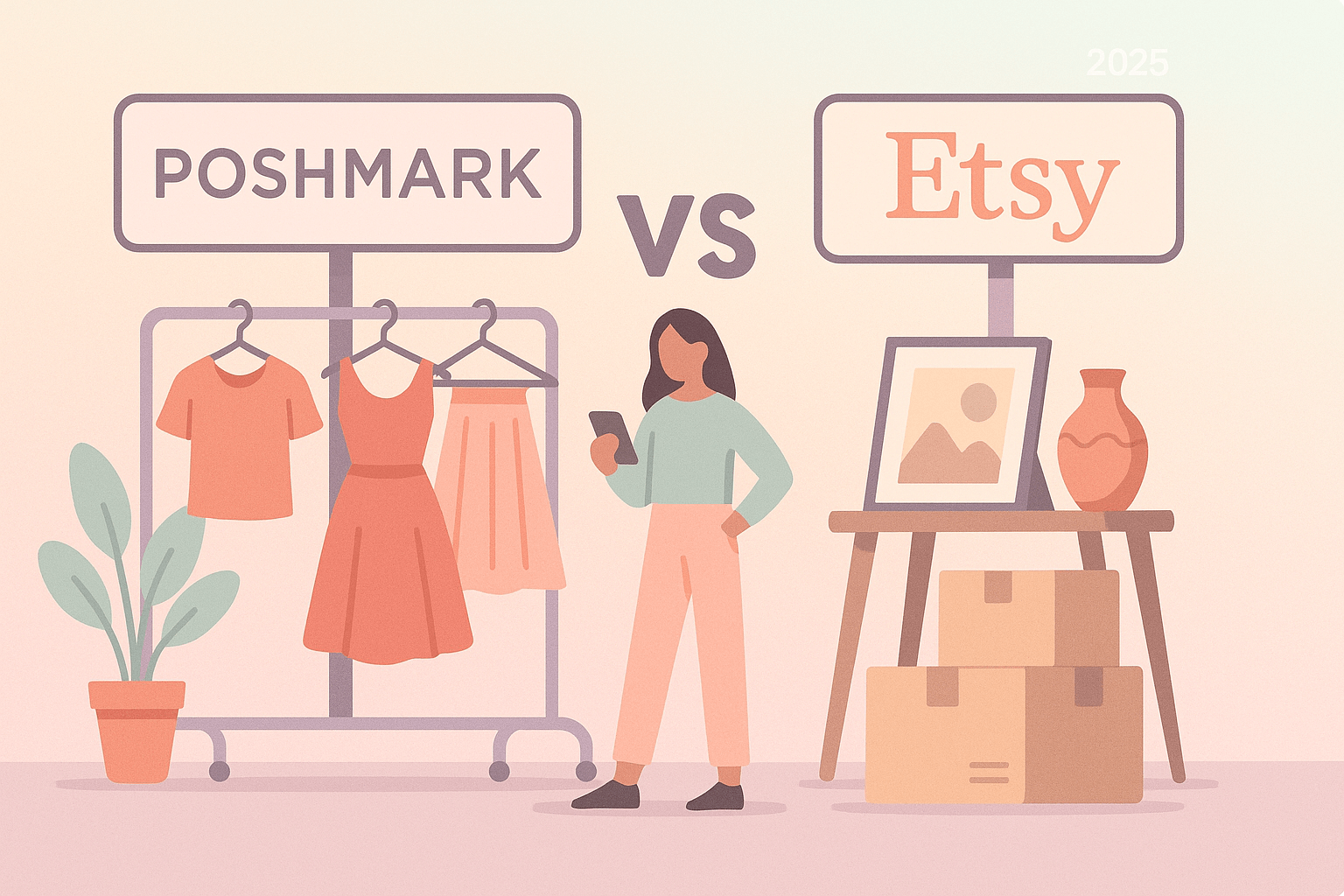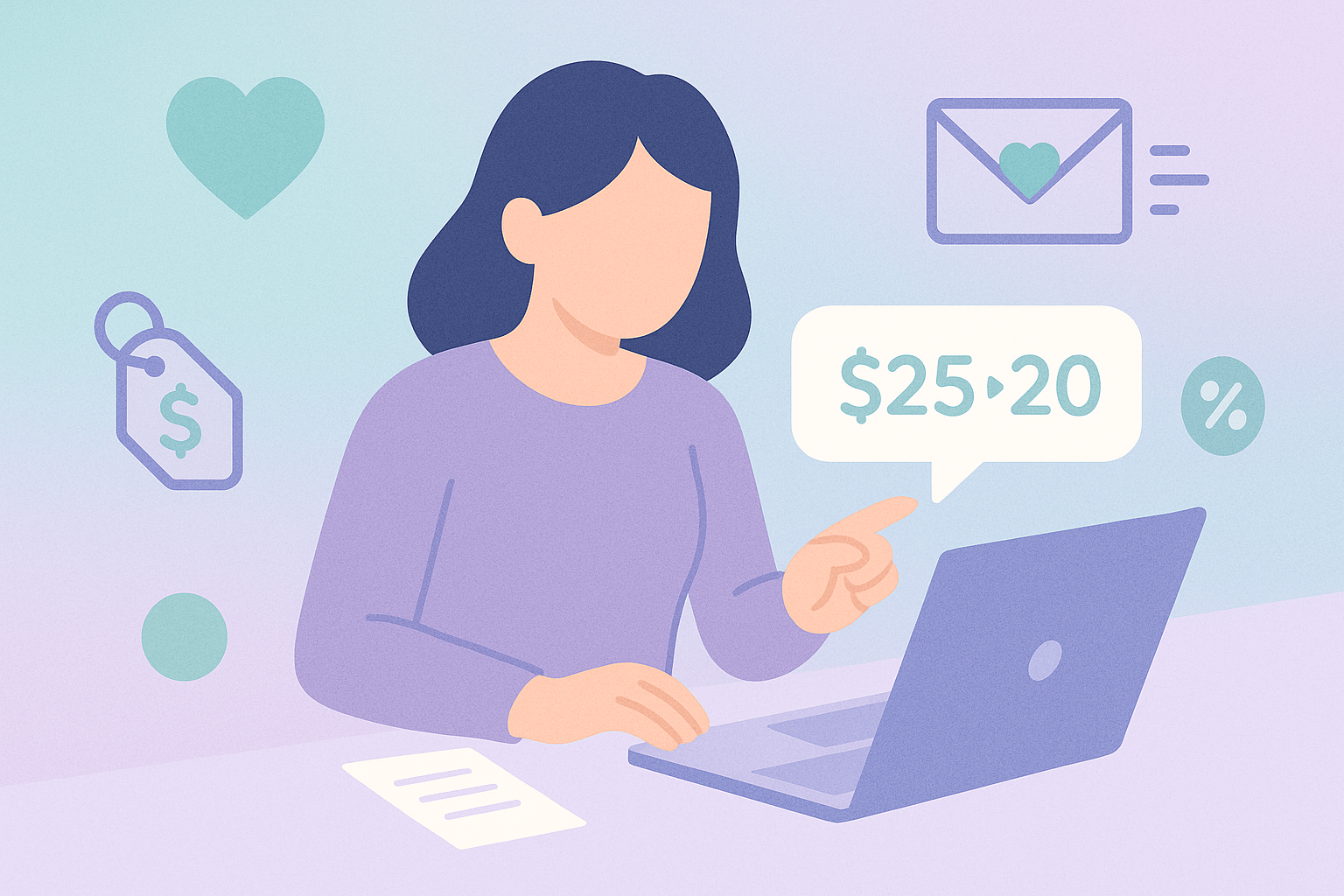Poshmark vs. Etsy: Which is better for resellers in 2025?

Poshmark is better for fashion resellers who enjoy social engagement, but Etsy suits artisans and vintage sellers focused on handmade or unique items.
For example, a clothing flipper selling designer handbags will find more success in Poshmark's fashion-focused community. But a jewelry maker crafting custom pieces should choose Etsy's creative marketplace.
Both platforms charge different fees and attract distinct buyer types. To make your choice, you’ll need to know how the platforms differ. We'll compare Poshmark vs. Etsy across fees, audiences, and features. You’ll also learn how Nifty helps you sell on both platforms without manual work.
Poshmark vs. Etsy: What’s the difference?
Poshmark is a fashion-first marketplace focused on apparel, shoes, and accessories.
In contrast, Etsy offers a broader selection of products than Poshmark and focuses more on handmade goods, like clothing, decor, and other unique products.
Poshmark’s features & highlights
Poshmark appeals to apparel and accessory resellers, offering a marketplace with over 130 million North American users. Sellers can share listings with potential buyers and host livestream events called Posh Parties and Posh Shows. They showcase and demonstrate products live to increase sales and connect with buyers.
Note: Check out our in-depth article on Poshmark’s features for a full rundown of the platform.
Etsy’s features & highlights
Handmade crafters list their products on Etsy to connect with buyers seeking niche, unique items. It serves over 95 million active users, appealing to customers who want to buy authentic, handmade goods, not cheap and mass-produced items.
Poshmark vs. Etsy: Feature-by-feature comparison
Poshmark focuses on fashion with social discovery, but Etsy covers handmade products. Both platforms differ in fees, buyer engagement, and shipping policies.
Let’s evaluate the differences between the two platforms:
Poshmark payouts and fees
Poshmark releases earnings after the buyer confirms delivery, or three days post-delivery if no claim is filed. Sellers can withdraw funds through direct deposit, check, or Poshmark credit once the balance is available.
Poshmark charges a 20% commission on sales over $15 and $2.95 on sales under $15. In exchange, sellers receive prepaid shipping labels, buyers get buyer protection, and sellers get social tools that drive visibility.
The high fees lower profit margins, but sharing features and Posh Parties help sellers increase their products’ visibility.
Etsy payouts and fees
Etsy lets sellers choose payout schedules such as daily, weekly, biweekly, or monthly. But the platform only processes payments once the account balance meets a $25 minimum (in U.S. dollars).
Sellers face stacked fees: $0.20 per listing, 6.5% on total sales, and 3% plus $0.25 for payment processing. Off-site ads add more costs, with fees of 15% for shops under $10,000 in sales and 12% once earnings pass that threshold.
The winner
Poshmark wins with a flat 20% commission, which is steep but more straightforward and more predictable. Etsy offers flexible payout schedules, but stacked fees reduce profits, and high-volume sellers must pay the 12% fee once they sell over $10,000.
Poshmark audience
Poshmark’s audience is fashion-focused, with buyers seeking apparel, shoes, and accessories. They actively search for luxury brand goods like Coach and Louis Vuitton, expecting to pay under market price.
Successful sellers connect with buyers through shares, live Posh Shows, and Closet Clear Out events, where sellers offer discounts for limited periods.
Sellers also succeed by staying active and sharing listings. When they engage potential buyers, sellers create relationships and keep their closets visible to the Poshmark community.
Etsy audience
Etsy’s audience is made up of shoppers who value creativity and authenticity. Buyers come to Etsy for handmade jewelry, custom art, vintage finds, and unique craft supplies they cannot get from big-box retailers.
This audience will often pay premium prices for quality and originality. Etsy shoppers also expect strong communication and polished branding from sellers, making it a strong fit for creators and collectors who want to build lasting customer relationships.
The winner
Poshmark wins for resellers who offer NWT apparel and accessories, as its audience is looking for these items. However, Etsy wins for crafters and artisans who offer unique, handmade pieces.
Poshmark listing workflow and SEO
Poshmark’s listing process is simple: Sellers upload photos, add details, and set prices within minutes, as it emphasizes quick fashion listings with social sharing. Visibility depends less on keyword SEO (search engine optimization) and more on consistent sharing, participation in Posh Parties, and activity within the community.
The platform prioritizes recently shared listings, making daily engagement an essential Poshmark strategy for sales. Titles and brand tags help buyers find items, but sellers see the most success when they stay active by engaging buyers with the social-driven discovery tools, like sharing and Posh Parties.
Etsy listing workflow and SEO
Etsy’s workflow requires more detail than Poshmark. Sellers must write keyword-rich titles, descriptions, and tags to keep their items visible in search results. SEO plays a central role, as buyers use keywords to find handmade, vintage, and craft items.
The platform also rewards shops with polished branding shown by precise product categorization and professionally edited photos. Success depends heavily on mastering SEO: Strong keyword use and branding help maintain visibility and drive sales.
The winner
Like with our Audience section, Etsy and Poshmark tie when it comes to workflow and SEO because each platform favors a different selling style.
Poshmark works best for sellers who enjoy community engagement, sharing, and live events to improve visibility. On the other hand, Etsy rewards sellers who excel at keyword research and polished branding.
The right choice depends on whether your style leans toward social-driven selling or search-driven optimization.
Poshmark shipping and returns
Poshmark recently dropped shipping rates from $8.27 to $6.49 for packages weighing up to 5 lbs, but added new rules. All orders ship via USPS Ground Advantage, with delivery in 2 to 5 days.
Buyers pay shipping fees on packages up to 5 lbs, but sellers must pay the extra cost if the package exceeds 5 lbs.
Be aware that USPS may refuse Ground Advantage shipments packed in Priority Mail materials, so be careful when you’re packing.
Priority Mail senders, take note: From October 12, 2025, Priority Mail packaging triggers a $5 fee deducted from your balance. You can upgrade to Priority Mail for an added cost, but you must use proper packaging to avoid penalties.
Etsy shipping and returns
Etsy provides shipping labels through USPS, UPS, and other carriers. It gives sellers complete control over shipping policies, return windows, and order handling. The platform supports international shipping with built-in tax calculations and customs forms.
However, Etsy requires sellers to manage shipping issues directly with buyers, as Etsy’s Purchase Protection is limited. To qualify for seller protection, valid tracking numbers are required, which can add costs that reduce profits on low-priced or lightweight items.
The winner
Etsy wins. Although Poshmark lowered rates and requires buyers to pay for orders up to 5 lbs, Poshmark doesn’t offer international shipping. Sellers will also need to pay more for packages heavier than 5 lbs.
Etsy offers flexible carriers, international shipping, and customizable policies that give sellers more control. Though sellers handle issues directly, its broader shipping options and global reach outweigh Poshmark’s limitations.
What real users are saying
We searched Trustpilot, Reddit, and other sources to bring you recent, real user feedback about Etsy and Poshmark.
Poshmark pros
- Longtime good experience with Poshmark: One user praised Poshmark, saying they’ve used the platform for over 5 years. The buyer never had any bad experiences with sellers. (May 8th, 2025)
- Positive experience selling on Poshmark: A user shared that they’ve had an excellent experience on Poshmark, with only minor issues that were quickly resolved. They praised the fair handling of buyer concerns and noted earning around $20,000 in a year. (July 18th, 2025)
- Success on Poshmark is possible: A seller explained that consistent effort leads to sales. Sometimes, they sell 10 items a day with under 1,000 listings. This seller stressed that daily listing, sharing, and pricing research help them succeed. (May 28th, 2025)
Poshmark cons
- Petty buyers can cause headaches: One seller recounted how, after declining repeated lowball offers on a Lululemon bag, a buyer retaliated by reporting every item in their closet as illegitimate. While Poshmark only removed a couple of items, the seller had to devote time and energy to the accusation. (April 29th, 2025)
- Bad return policy: A buyer complained that Poshmark’s support team denied their return even though the seller provided incorrect measurements and proof. (August 23rd, 2025)
- Unfair policies and design: A reviewer said that Poshmark feels outdated and unfair. They criticize the party features, inconsistent enforcement, and tolerance of low-quality items while removing quality listings. (September 9th, 2025)
Etsy pros
- SEO and branding experience help: A user noted that understanding keyword optimization and marketing beautiful product photos is key to success on Etsy. (December 26th, 2024)
- Connects buyers with one-of-a-kind creations: A user praised Etsy for offering great quality and better deals, highlighting positive experiences purchasing from multiple artists. They appreciated how the platform gives small businesses opportunities to share unique products with a global audience. (September 6th, 2025)
- Seller can attain success: A shop owner shared their excitement about hitting 1,000 sales after three years of selling custom folded book art and unique Cricut patterns. They credited trial and error, late nights, and steady effort, encouraging new sellers to stay patient as momentum builds over time. (September 8th, 2025)
Etsy cons
- Skewed toward buyers: A seller complained that Etsy unfairly favored a buyer during a recent dispute. (February 10th, 2025)
- Unfulfilled order on Etsy: One buyer described a frustrating Etsy purchase where the seller set strict “boundaries” for their shipping policy, delayed shipping beyond the stated timeframe, and never actually sent the item. After requesting a refund, they received no explanation or communication. (September 12th, 2025)
- Success overshadowed by IP theft and complications: A seller reflected on building a successful Etsy shop with nearly $200K in sales, viral listings, and organic growth without ads. Despite bestsellers, their designs and photos were repeatedly stolen. (September 9th, 2025)
How to make your choice
Consider the items you’re selling and your sales and marketing style to make your choice between Poshmark and Etsy. Poshmark works if you’re selling clothing and accessories, while Etsy appeals to folks selling niche art and handmade crafts
Poshmark is better for …
- Community marketing and social discovery: Poshmark’s sharing system, Posh Parties, and community features boost visibility and connect listings with the right buyers.
- Selling higher-value items with confidence: Authentication services and buyer protection help minimize fraud risks on luxury products.
- Easy shipping policies: Poshmark supplies prepaid USPS labels, flat-rate pricing, and simple processes that make shipping straightforward for sellers.
Etsy is better for …
- Selling handmade goods: Shoppers searching for handmade, vintage, and unique products use Etsy instead of big-box stores. These buyers are willing to pay more, so sellers face less price pressure.
- An easy listing process: The platform’s interface is beginner-friendly, with quick setup, template saving, product duplication, and auto-renewal to simplify management.
- Focusing on building a brand: Etsy lets sellers personalize their shop with banners, logos, and consistent branding that strengthen customer trust.
My verdict
Poshmark is the stronger choice for fashion sales, whereas Etsy fits handmade and vintage sellers who rely on SEO and branding to reach buyers. Each platform has clear strengths but also limitations in workflows, fees, and scaling.
If you sell products that appeal to both audiences, I recommend you crosslist on both platforms. Crosslisting on Poshmark and Etsy increases your chances of moving more products.
Use a crosslisting tool like Nifty, which provides you with a command center to manage all your inventory in one place, so you don’t have to jump between platforms.
List on both Etsy and Poshmark with Nifty
Don’t choose between Poshmark vs. Etsy — list on both platforms, and manage your inventory with Nifty. It’s the best AI crosslisting tool that generates descriptions, updates your inventory, and provides sales analytics. Here’s how Nifty can help:
- AI-generated listings from photos: Upload an image and Nifty’s AI builds the listing with optimized titles, detailed descriptions, hashtags, and completed fields.
- Crosslist now: With a couple of clicks, post your items across Poshmark, eBay, Mercari, Depop, and Etsy. No copy-paste, no multi-tab, it’s all in the background. (More marketplaces coming soon!)
- Automatic delisting? Sorted: When you make a sale, Nifty’s sales detection auto-delists that item from every marketplace. No more accidental double-selling or “sorry, it’s already gone” apology messages.
- Bulk tools = set it and forget: Share and relist daily without lifting a finger. Update or discount dozens of items at once. You can even schedule drafts to go live while you sleep.
- Track performance: Monitor sales, fees, top products, and slow movers in one dashboard to identify trends and focus your efforts.
Nifty works for sellers of all sizes and pays for itself. Start your 7-day free trial today and see how Nifty can simplify selling on both Poshmark and Etsy.
FAQs
1. Is Poshmark worth it for new sellers?
Yes, Poshmark is worth it for new sellers who focus on fashion and accessories. The platform offers simple listing tools, prepaid shipping labels, and built-in buyer protection. However, the 20% commission fee is steep, and success requires daily sharing and community engagement.
2. How much does it cost to sell on Poshmark?
Poshmark costs nothing to list items, but charges a 20% commission on sales over $15 and a flat $2.95 fee on sales under $15. Buyers pay $6.49 for shipping for packages up to 5 pounds. Sellers pay extra fees for packages over 5 pounds or if they choose Priority Mail.
3. Is it cheaper to sell on Etsy or eBay?
eBay is generally cheaper than Etsy for most sellers. eBay charges 10–15% final value fees with 250 free listings monthly. Etsy stacks multiple fees: $0.20 per listing, 6.5% transaction fee, 3% payment processing, plus mandatory 12–15% off-site ads for sellers with over $10,000 in revenue, totaling 15–25% in fees.





